Store-bought lemon curd doesn’t even deserve to share the same name as homemade. This from-scratch lemon curd is deliciously tangy, creamy, and sweet. You only need 5 ingredients and it comes together on the stove in 10 minutes! Lemon curd is perfect for scones, crepes, angel food cake, quick breads, pound cake, and so much more.
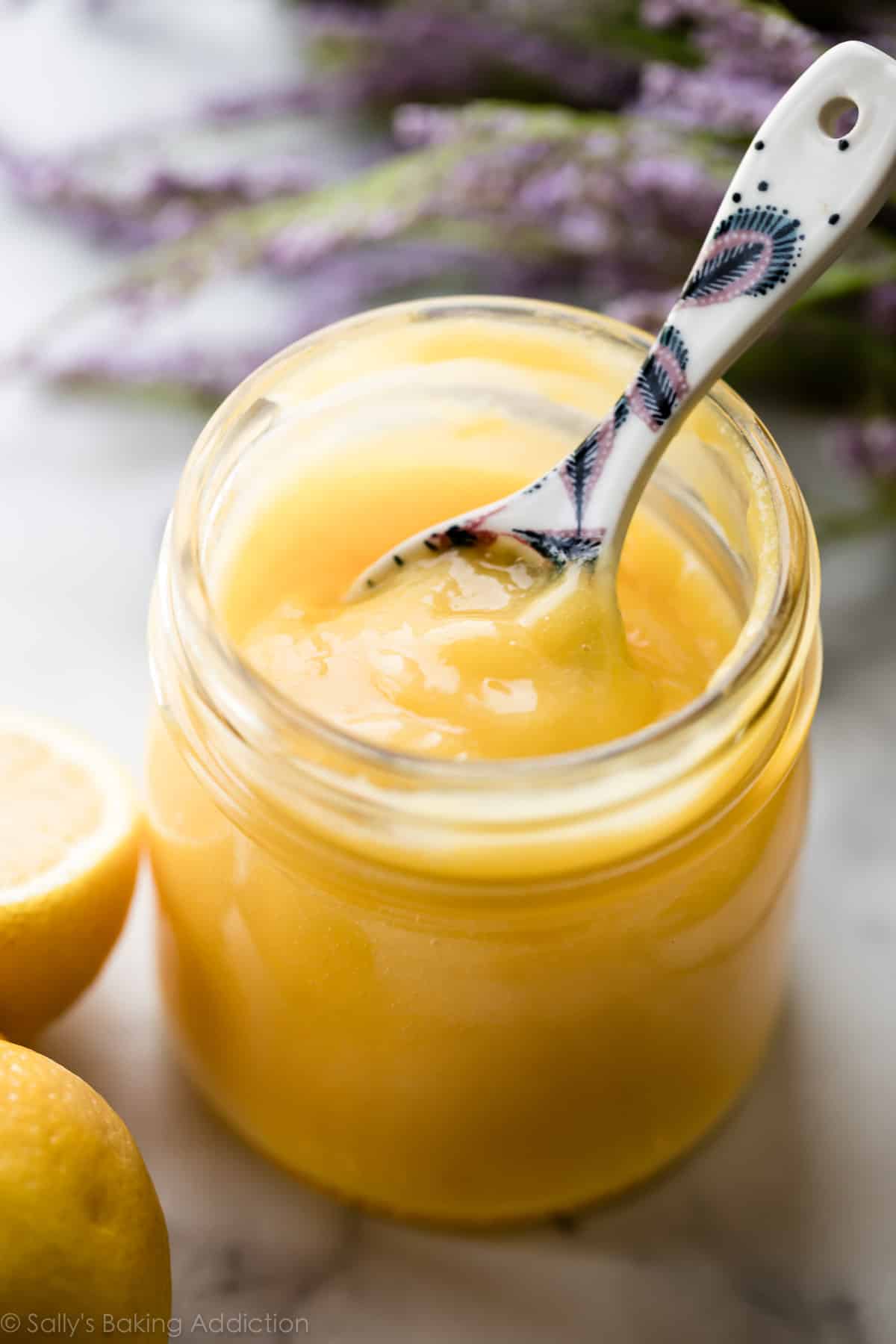
Let’s talk lemon.
- Are lemon bars your main squeeze?
- Is lemon blueberry cake your favorite dessert?
- Are you head-over-heels for lemon meringue pie?
If your answer is YES to all of the above, you’re going to flip for this creamy, dense, intensely flavorful spread. Homemade lemon curd is 1 million times tastier than store-bought, which is filled with ingredients we can’t pronounce and has likely been sitting on the shelf for too long. Spread the blissful homemade version on scones, biscuits, homemade English muffins, and so much more. This is the recipe you never realized you needed!
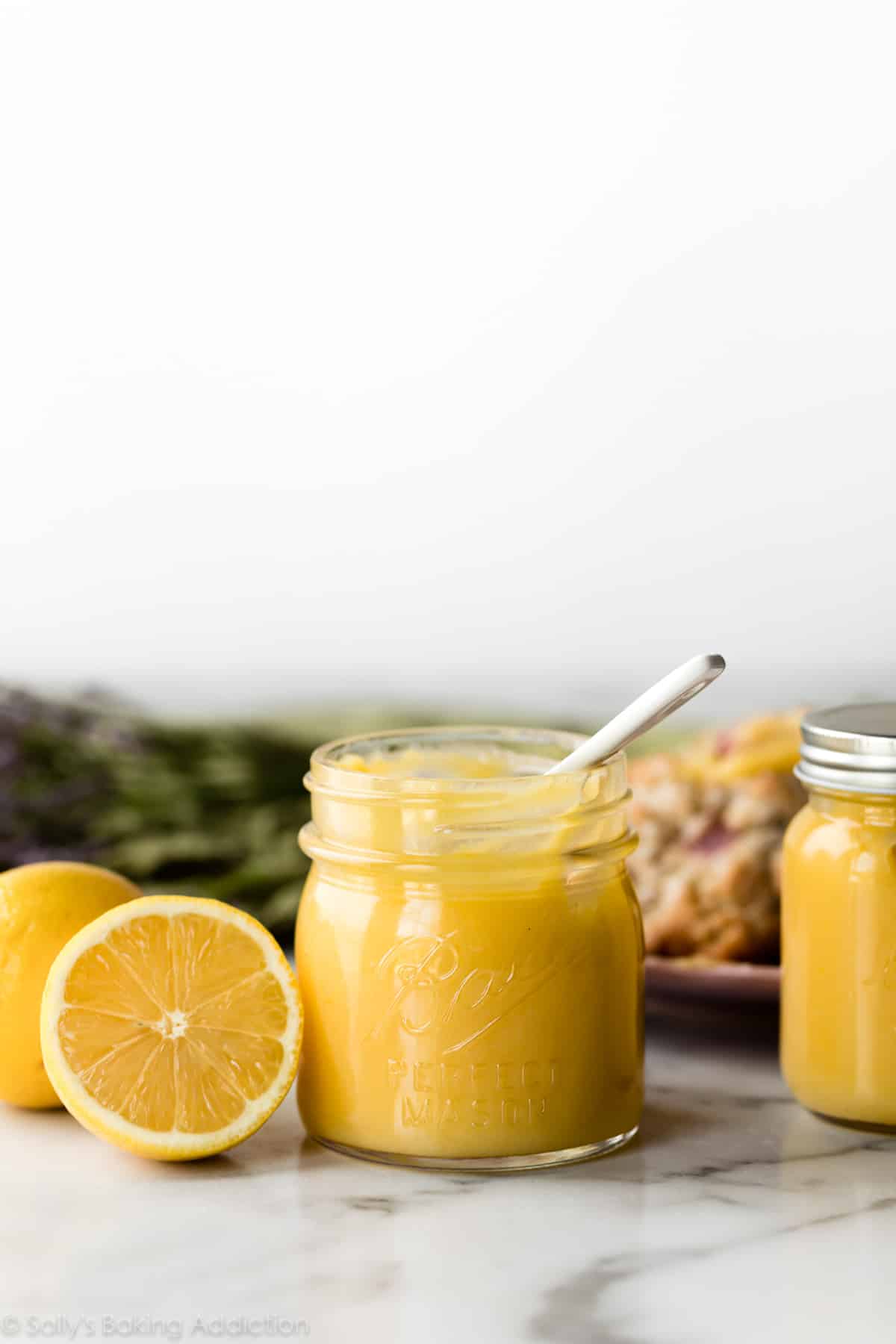
What Is Lemon Curd?
Lemon curd is a very rich dessert topping or spread. It’s buttery and sweet with intense tart lemon flavor—like a creamy lemon version of jam. Lemon curd is made from simple ingredients and comes together quickly on the stove. Lemon lovers, this is your jam.
Get it? Get it? 🙂
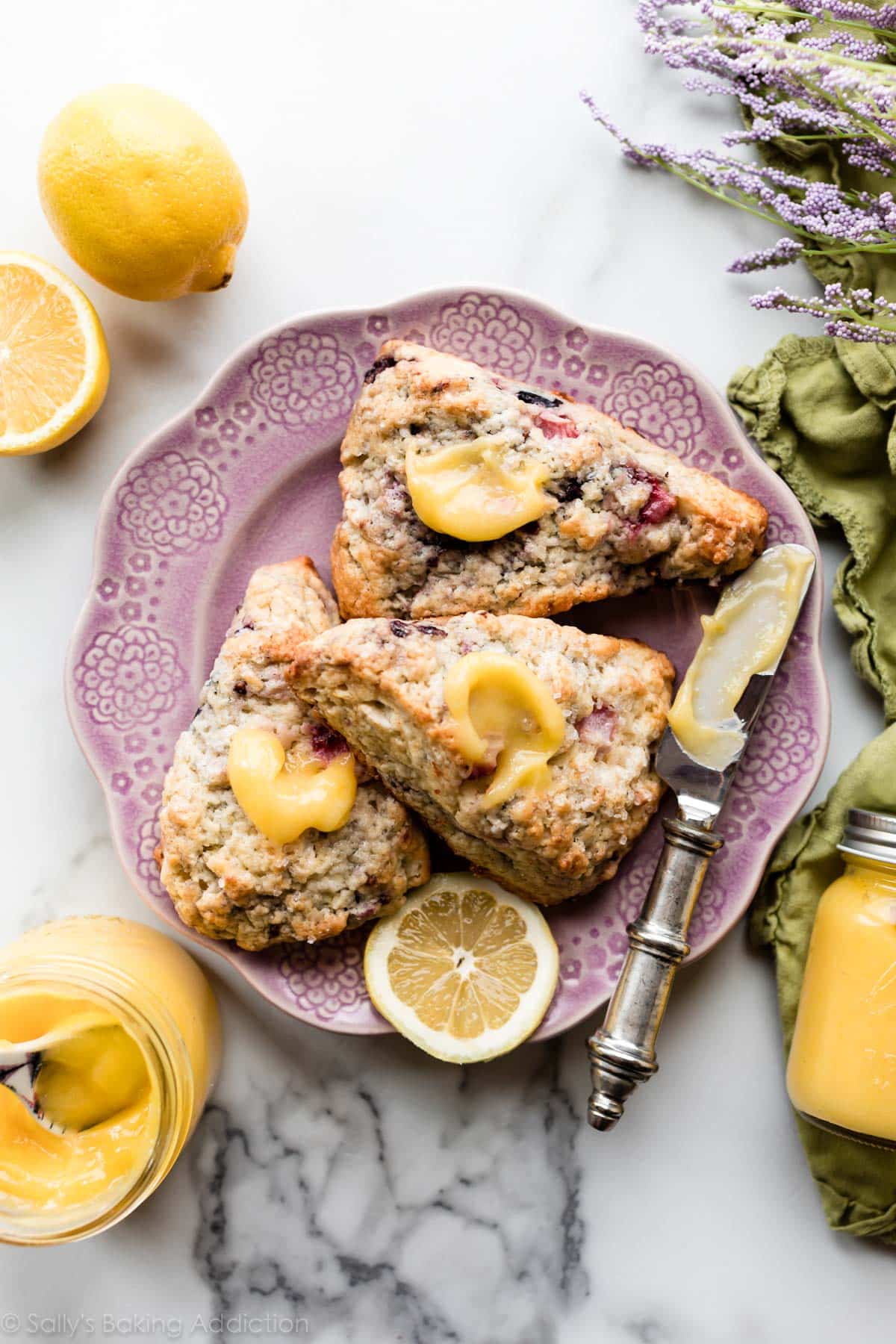
How to Make Lemon Curd
Here’s how we make DIY lemon curd. The full recipe and instructions are below.
You need 5 ingredients for lemon curd recipe: egg yolks, fresh lemons, sugar, salt, and butter. Each ingredient serves a critical purpose for thickening and flavoring. The egg yolks thicken the curd, just as they do in creme brûlée or butterscotch pudding. Use real lemons; you need both the zest and juice. The sugar supplies sweetness and structure, while the salt balances out the flavor. Add the butter after the curd finishes on the stove. Butter makes it super creamy.
Make lemon curd on the stove. Make sure you are constantly whisking as the mixture thickens—we’re talking about 10 minutes of whisking. The good news? That’s the only step in this recipe: whisking!
Use a Double Boiler
I strongly recommend cooking the lemon curd in a double boiler because mixing these ingredients over direct heat quickly leads to burning. Don’t fret! If you don’t have a double boiler, craft a makeshift double boiler by placing a heatproof glass bowl on top of a larger pot. (You can see my DIY double boiler in my brownie baked Alaska post!) Make sure the bottom of the top pot or bowl does not touch the simmering water. It’s worth repeating: lemon curd should never be cooked on direct heat.
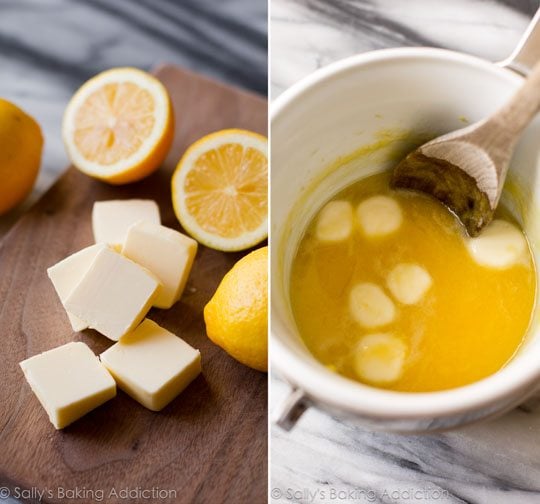
Why Does My Lemon Curd Taste Metallic?
Lemon curd may have a metallic aftertaste if you cook it in a metal double boiler. It’s a result of the eggs and lemon reacting with the pan, but is easily avoidable! Use a non-metal double boiler (this one has a porcelain insert) or the glass bowl option I mention above (but make sure it’s heatproof glass, like Pyrex). While you’re at it, use a silicone whisk too!
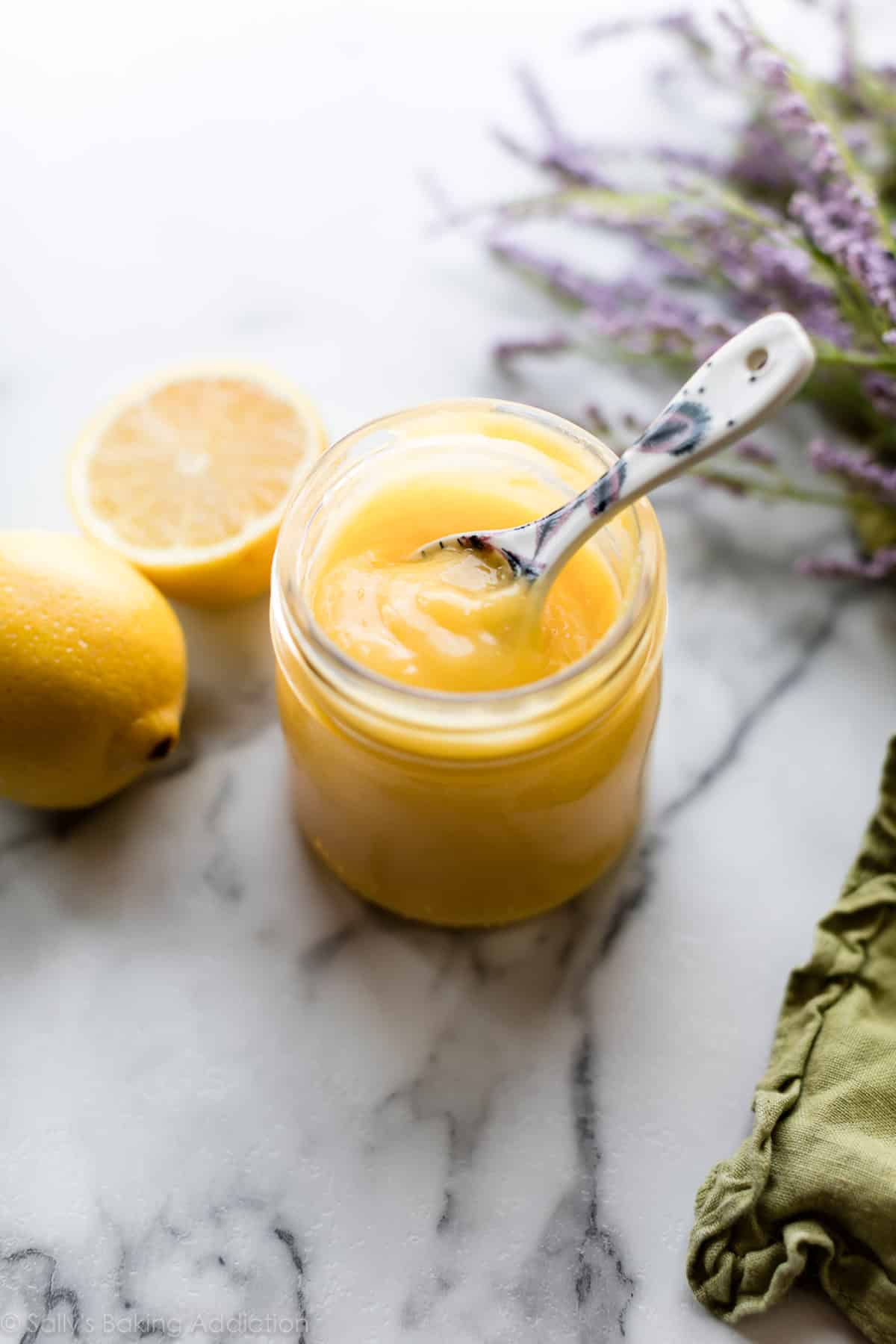
Uses for Lemon Curd
There are so many ways to enjoy lemon curd. Here are a few suggestions:
- Enjoy on scones, muffins, buttermilk waffles, or whole wheat blueberry pancakes
- Use as a filling for crepes, lemon cupcakes, or lemon coconut cake
- Use as a topping for pound cake or pavlova (uses the egg whites!)
- Fill French macarons, choux pastry, or layer on strawberry shortcake
- Make a lemon berry trifle
- Spread on English muffins, homemade biscuits, toast, croissants
- Mix it with whipped frosting for the fluffiest filling in a citrus cake
- Top your classic cheesecake, lemon cheesecake, or easy cheesecake pie
- Stir in yogurt, cottage cheese, or spoon on ice cream
- Try it on gingerbread waffles (seriously, try this!)
- Use as a filling to add extra flavor to lemon blueberry cupcakes
- Fill your lemon thumbprint cookies
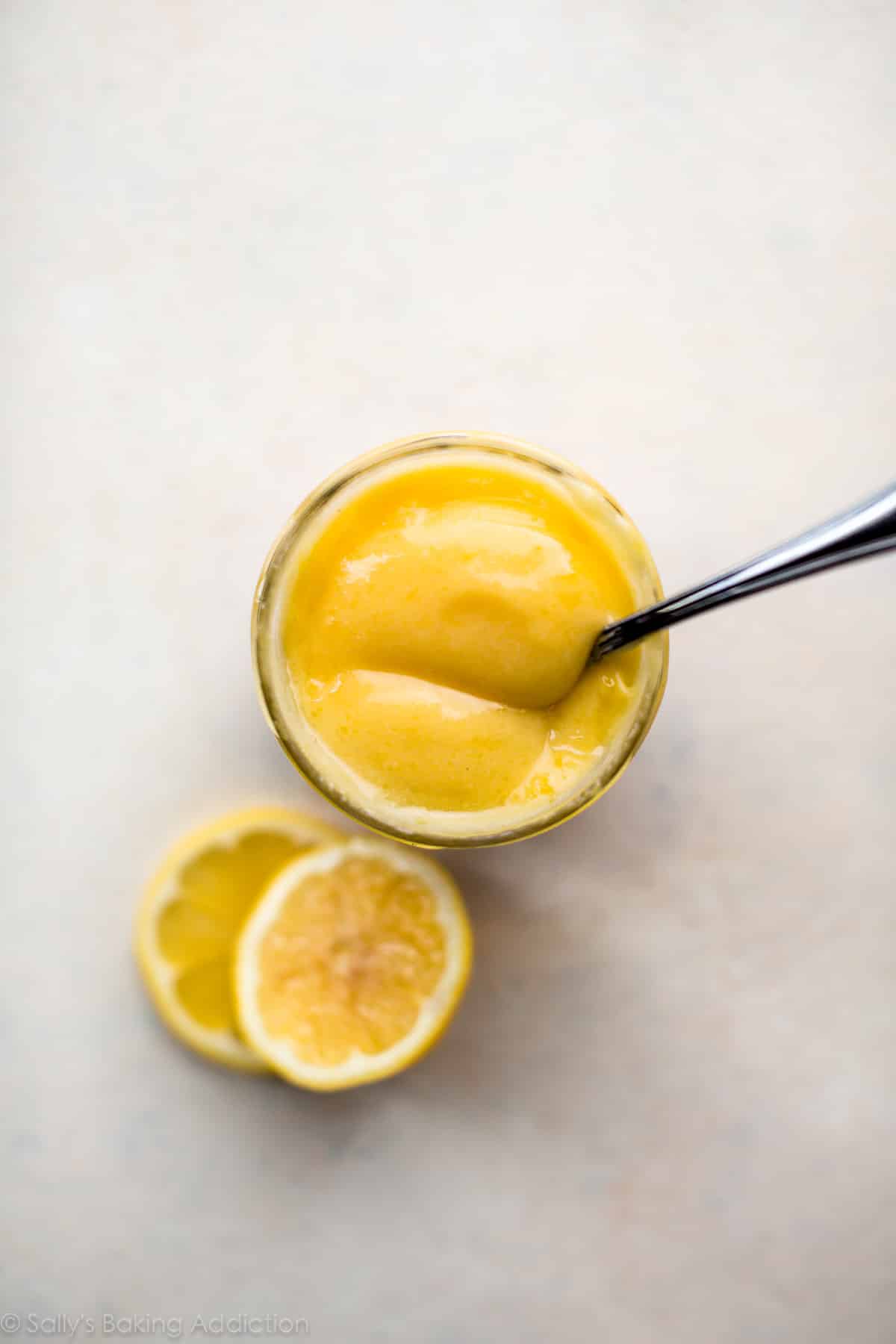
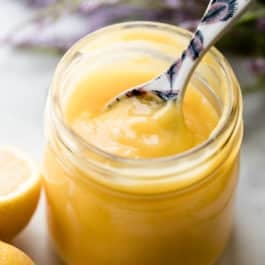
Lemon Curd
- Prep Time: 5 minutes
- Cook Time: 10 minutes
- Total Time: 1 hour, 15 minutes (includes cooling)
- Yield: 1 – 1.5 cups
- Category: Dessert
- Method: Baking
- Cuisine: American
Description
You only need 5 simple ingredients for homemade lemon curd—and the recipe comes together on the stove in 10 minutes! If you know how to whisk, you can make this delicious spread.
Ingredients
- 4 large egg yolks (for thicker lemon curd, see Note on eggs)
- 2/3 cup (134g) granulated sugar
- 1 Tablespoon lemon zest (about 1 lemon)
- 1/3 cup (80ml) fresh lemon juice (about 2–3 lemons)
- 1/8 teaspoon salt
- 6 Tablespoons (85g) unsalted butter, softened to room temperature and cut into 6 pieces
Instructions
- Fill the bottom pot of your double boiler with 1–2 inches of water. (Or use the DIY double boiler method listed in the notes.) Place on high heat. Once the water begins to boil, reduce to low heat to keep the water at a simmer.
- Place egg yolks, granulated sugar, lemon zest, lemon juice, and salt into the top pot of your double boiler. Using a silicone whisk, whisk until completely blended, then continue to whisk as the curd cooks. Constant whisking prevents the egg yolks from curdling. Whisk and cook until the mixture becomes thick, resembling the texture of hollandaise sauce, about 10 minutes. If curd isn’t thickening, turn up the heat and constantly whisk.
- Remove pan from heat. Whisk the sliced butter into the curd. The butter will melt from the heat of the curd as you whisk. Pour curd into a jar or bowl and place a piece of plastic wrap directly on top so it is touching the top of the curd. (This prevents a skin from forming on top.) The curd will continue to thicken as it cools. Once cool, the plastic wrap can be removed.
- Refrigerate the curd for up to about 10 days.
Notes
- Freezing Instructions: For longer storage, you can freeze the curd up to 3–6 months. Thaw in the refrigerator overnight before enjoying.
- Special Tools (affiliate links): Egg Separator | Citrus Juicer | Citrus Zester | Non-Metal Double Boiler | Silicone Whisk
- Thicker Lemon Curd: For thicker lemon curd, replace 2 of the egg yolks with 1 whole egg. This means you will use 2 egg yolks plus 1 whole egg. Keep the rest of the recipe and instructions the same.
- Lemon Juice: Do not use bottled lemon juice. Use fresh-squeezed lemon juice.
- Butter: You can use salted butter instead of unsalted butter. Simply omit 1/8 teaspoon salt in the recipe.
- No Double Boiler? No Problem! If you do not own a double boiler, you can simply place a small heatproof glass bowl over a saucepan of simmering water—you will cook the curd in the top pot/bowl.
- No Straining: I don’t strain the lemon curd. The zest is very tiny and has been cooked, so you can hardly detect its texture. It’s really just there for flavor. However, feel free to run the finished lemon curd through a fine mesh sieve if you want to take the extra step.



















I can’t believe how easy this was to make and how delicious it turned out. I will be adding it to the top of a cheesecake along with candied lemons for garnish.
Thank You!
Awesome recipe! I just used it to make passion fruit curd to use as a cake filling. All I did was swap the lemon juice for an equal amount of Goya frozen passion fruit pulp and it came out perfect!
Do you think I could replace the lemon juice with canned pineapple juice (and reduce the sugar slightly)?
I haven’t personally tried it, but I wouldn’t change anything. You can try slightly reducing the sugar. Let me know how it turns out!
Love this recipe!! I never realised how many different ways to use this. I have canned the curd, it was wonderful although the lid was hard to pry off. I also kept it in the fridge because of the ggs included. I am making another batch today and my next time I am trying lime.
I used this recipe to make lemon curd for the first time ever and it was delicious! I did use the 3-egg method with 2 yolks and 1 whole egg. The mixture was very foamy while in the double boiler but I was able to mix away the foam once the mixture was cool. I only added 1/3 cup sugar so it was more tart. Turned out thick, super creamy and yummy! My family loves it and we put it on everything!
Tried it for the first time in life, the result was remarkable, infact I found myself licking my fingers after pouring the content from the blender, touching it ( the blender) now and then. The whole experience was new and wonderful ❤️ . Thanks and love from India.
Hi Sally, I made this just now and I’m thrilled with how it came out. I too had to cook it longer (about 15 minutes) but it looked like hollandaise when I took it off. I just wanted to check, I can’t overcook it can I? It’s quite thick, like a cake batter but the taste test I did washing the bowl was lovely! I am a little worried I’ve overcooked it.
Made this today and was really pleased with the result. I used a metal pan over boiling water and whisked it the entire 10 minutes. Thickened up perfectly, whisked it like crazy to incorporate the butter. Delicious and smooth, very thick. Love the flavor and the texture.
Hi Sally — I made your curd today (using a combination of kaffir limes and a Meyer lemon I had on hand), and I have a couple of observations/questions.
1) I used a Pyrex mixing bowl for a non-metal top vessel for my double boiler. I got the water boiling (and the bowl heating) even before I started prepping the other ingredients. Still, did not thicken much after 10 minutes of cooking/whisking, so as mentioned in the recipe, I increased the heat (gas) and kept whisking … and kept increasing the heat and whisking! I finally stopped after 40 minutes (!!) It was thicker, but not nearly to what I would call Hollandaise sauce thickness. Is Pyrex too-insulating a material to use for this purpose?
(Next time I might risk the “metallic” taste and use the stainless steel double-boiler top, which should heat faster, I’d think.)
2) When I added the butter and stirred the mixture, it seemed that the eggs began to curdle immediately. (They were smooth as silk when I took them off the heat.) When I poured the curd into the Mason jar, it had a top film of clear, watery fluid. What might have caused this separation?
In retrospect, I’m wondering if I should have whisked in the butter (vs. “stir”, which implies using a spoon, perhaps even gently).
Hi Mike! Thank you so much for reporting back about the lemon curd– I, too, have used a pyrex bowl as a mock double boiler for this with no issues, so I don’t think that the bowl is too thick. How hot was the water beneath? Was it already simmering when you placed the bowl on top and began? Using a whisk when you add the butter could definitely help reduce the risk of curdling. I also believe there was curdling because the mixture (possibly) wasn’t thickened enough. Did you use the only egg yolk option or full egg option? Just curious.
Hi Sally — The water was at a full boil, and I’d started it early to be sure the Pyrex bowl would be hot when I added the ingredients. I used egg yolks only; I’ve never made curd with the entire eggs, but maybe I should try it. I figured that after 40 minutes of heating & whisking, it was as thick as it was going to get.
After the curd cooled, a hard pad had formed on top, almost like the old paraffin seal. I’m thinking that it was unincorporated butter (due to the stirring, not whisking). But we let it come to room temperature and whisked it in the jar (we have a tiny whisk, too) and got it to re-incorporate.
The flavor on the finished curd, btw, is fabulous. The kaffir lime around and tartness is just what we’d hoped for. Next time, I hope to get the technique down so it doesn’t take so long and doesn’t go through a lumpy phase. 🙂
Divine! I will say though, I had to cook this closer to 25 minutes, and the water was at a rolling boil the whole time. Not sure why, as I made it exactly to recipe. Also, I did strain it and while it would have still been tasty as it was with the zest inside, straining it just took it up to silly, smooth perfection.
Soooooo good! Worth the whisking time. My husband even did a little “dance” after tasting it!
Can I revert the sweetness of the cure once it’s finished? I found it a bit on the sweet side and want to strengthen the lemon flavour without having to discard the first batch?
Hi Eunice! Feel free to stir in a bit of lemon zest or an extra squeeze of lemon juice to help offset the sweetness.
Lovelyyyy!!! Thank you so much!
Made this a few days ago, I would like to make more and freeze
If I double up the recipe do I have to increase whisk time?
Hi Lorraine! So glad you enjoyed this lemon curd. When working in larger batches, the cook time will need to be slightly extended until it thickens up.
Hi im wanting to make this for a school project to put in some crepes we’re going to roll. We only have 70 minutes to make it so i was wondering whats the minimum time you would let it cool and be able to use it without being completely runny and being thick enough to hold some crepe pinwheels together.
About 20 minutes in the refrigerator would be the minimum I suggest. 🙂
1st try- love it so simple and completely satisfying to make
Question- while whisking my lemon curd turned very foamy, and need up full of bubbles when done cooking. I followed the recipe for the thicker curd in the recipe notes, so maybe the egg white got too whipped in the process? Any other thoughts? Thank you!
Hi Jenny! I’m just seeing your question now, my apologies. I’ve never had this happen to me before, but I’m going to assume it was the constant whisking. Did the bubbles evaporate after storing? Hope you enjoyed it.
Made this for the first time today and it tastes great! However, I left it in the fridge to cool and (ideally) thicken up some more, but it’s still somewhat runny. I was hoping to use it in a layer cake, but at its current consistency it’s likely too thin to do that.
I read the part about using a whole egg in place of 2 egg yolks AFTER I was already in progress with all yolks. I’m hoping there’s a way to salvage what I have so I don’t have to start over from scratch. Any thoughts? Is adding it back to the double boiler for more time an option? What about some sort of thickener? Any help would be appreciated, thanks!
Hi Quaid, it gets remarkably thicker after chilling– in fact, I use the egg yolk version all the time as a filling for cakes. If it’s still not thick enough for a layer cake, you can try reheating it on the stove and whisking in 1/2 teaspoon of cornstarch.
Made these as gifts when we go to friends home for dinner. We have lemon trees so I’m always looking for great lemon recipes. This was a big hit. Thank you
I literally can’t get enough of this recipe. I’ve done it as a lemon curd and a lime curd multiple times and I normally just eat it straight from the jar. For some reason, my lime zest seems smaller (despite using the same zester) so I push it through a strainer and it’s perfect. Otherwise, I follow the recipe exactly and keep the jar hidden in the back of the fridge. This never lasts me more than a week!
Been making lemon curd for years (Mum is Australian), but a friend uses your recipes all the time with great success, so thought I would give it a try. This is better than my recipe and the hints about the make-do double boiler, and thicker curd were so helpful. Am following you now and your scones are up next. Btw…I licked the bowl!
I’m delighted! So easy, so smooth, excellent and very detailed explanation (with cups and spoons but also with grams and millilitres for us Europeans) ! Thank You, dear Sally and very happy New year! Greetings from Belgrade, Serbia!
Decades ago an English friend introduced me to lemon curd. I’m mortified to report that I ate an entire jar with a spoon. I have avoided it since, for obvious reasons.
Now, I have moved South and I have two Meyer Lemon trees that provide me with 50 or 60 lemons each winter. How many preserved lemons, or how much lemon marmalade can one make? So this year I tried your curd recipe. Excellent!! Better than I even remembered! ( I have hidden every spoon in the house. lol.) can’t wait to try a lemon coconut cake.
Hey Sally! I make your recipes ALL THE TIME! Honestly- probably multiple times a week. Thank you for your amazing blog! I tried this curd today, and I failed miserably. 🙁 . Cooked on the double boiler for 15 minutes and was still thin as water. Turned up the heat for another 8 minutes and it never thickened, and then became grainy. I am a pretty experienced baker and was so surprised I couldn’t do this. Is there a standard problem when curd never thickens? Did I not get it hot enough? I whisked the *entire time*- was I supposed to do that? I literally cannot think of what I might have done. Am I just bad at Curd? :-/
Hi Renee, Thank you for using my recipes so often! Did you use only the yolks of 4 eggs for your lemon curd? For thicker lemon curd, replace 2 of the egg yolks with 1 whole egg. This means you will use 2 egg yolks plus 1 whole egg. Keep the rest of the recipe and instructions the same.
I just made this to surprise my husband with a vanilla cake with lemon curd and coconut cream cheese frosting. I don’t know if the lemon curd will make it to the cake, I just might eat it with a spoon! So delish!!!
Tripled the recipe yesterday using Meyer lemons, and 6 yolks and 3 whole eggs. Came out perfect. Took longer to thicken though given the extra mass. Tried to get it to 170 degrees but got stuck at 160ish. Consistency seemed ok though so I removed from heat. Strained the curd before jarring. Been looking for a good curd recipe that isn’t grainy and can use whole eggs! Thank you!
Making the Angel Food cake for husband’s birthday and using yokes for Lemon curd, both his favorite’s for his 65th birthday this Thursday the 16th can’t wait! I am glad for the tip to read the entire recipe first, great idea in this case and also the tips at the end, as I am going to make ahead and bring to restaurant the next day. Always make day before, just in case I have a problem
Incredible, just wanted to take a spoon to the bowl! Made this for little tartlets and your recipe didn’t disappoint. Thank you.
Wondering about dairy free options. Can I use Earth Balance or Myokos butter instead of dairy butter?
Hi, Maureen – I haven’t tried this recipe with any dairy-free alternatives, but you can certainly give it a try. If you do, please let me know how it goes!
Thanks Sally for this simple recipe. The first time I made it, the curd turned out perfectly! Just like the picture, which never happens. I have tried it 4 more times and the consistency keeps turning out wrong, almost like stretchy taffy. I can’t think of anything I’m doing differently than the first time. Any suggestions?
Hi Tiffany, Are you using just the egg yolks (no whites?). Make sure the bottom of the top pot or bowl does not touch the simmering (not boiling) water and keep whisking the entire time it’s cooking!
Made this to go in a lemon meringue cheesecake and kept the whites aside for the meringue. The curd tastes great and I was able to save wasting 4 egg yolks